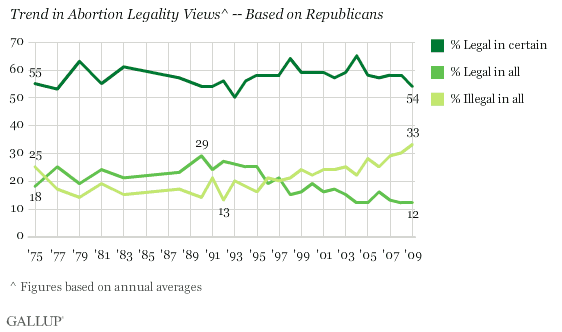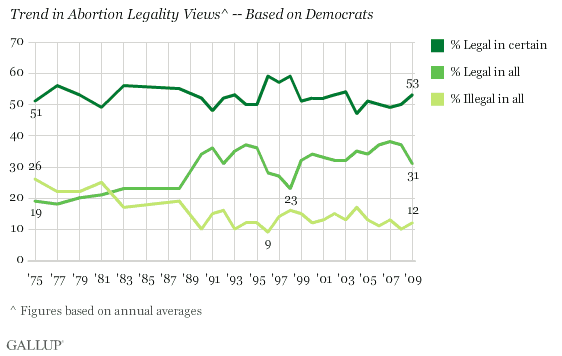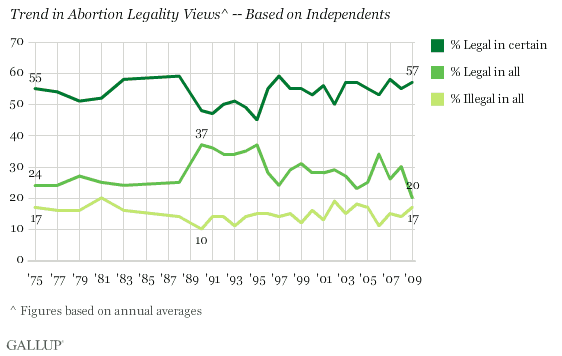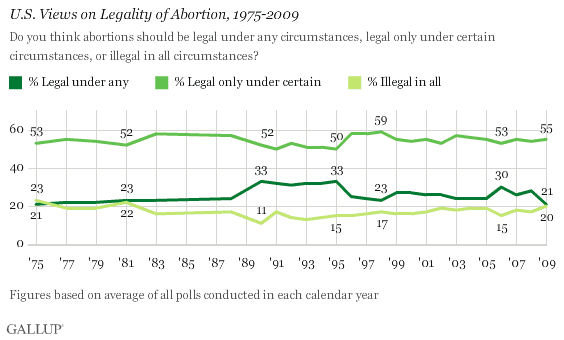PRINCETON, NJ -- With congressional passage of healthcare reform potentially hinging on a battle over abortion funding, ÓÅÃÛ´«Ã½finds that Americans' views on the extent to which abortion should be legal in 2009 were nearly identical to their outlook in 1975 -- though support has fluctuated somewhat over time. However, the underlying trend by party shows that Republicans' and Democrats' views on the contentious issue have become increasingly polarized.

Gallup's long-term abortion question -- instituted two years after the landmark 1973 Roe v. Wade case gave sweeping constitutional protection to abortion -- asks Americans to say whether they believe abortion should be legal "under any circumstances," legal "only under certain circumstances, or "illegal in all circumstances."
In the broadest terms, the largest segments of Republicans and Democrats have consistently preferred the middle "legal only under certain circumstances" abortion position. What's changed since 1975 is that the percentage of Republicans favoring the "illegal in all circumstances" position has grown and the percentage favoring the "legal under any circumstances" position has decreased. The reverse pattern is seen among Democrats.


Among independents, the overall outline of views has been more stable. While most take the middle position, independents favoring the availability of legal abortion under any circumstances have consistently outnumbered those who favor keeping it illegal in all circumstances (albeit by a dwindling margin in recent years).

Overall Views on Abortion Return to Base-Year Attitudes
Among all Americans, the dominant view over the past 3 ½ decades has been the moderate "legal only under certain circumstances" position. Several changes occurred during the 1980s and 1990s in the balance of preferences for the two extreme views -- always legal vs. always illegal -- but in 2009, attitudes were back to their original 1975 levels.

Bottom Line
Among all Americans, public opinion on abortion appears to have been fairly stable since 1975, with modest changes in the percentages of Americans taking either of the two most extreme positions. This overall stability in views obscures a transformation that has taken place in the ways the two major parties approach the issue. Whereas Republicans and Democrats had similar outlooks on abortion in the 1970s and 1980s, that started changing in 1990; and by 2009, more Republicans believed abortion should be illegal than broadly legal (by a 21-point margin), while the reverse was true among Democrats (by 19 points).
This is the first of a three-part series reviewing long-term changes in Americans' abortion views. Parts 2 and 3 will review trends by gender, age, age cohorts (in which ÓÅÃÛ´«Ã½follows each age group in the trend data as its members age, beginning in 1975), and other population subgroups.
Survey Methods
The trends reported here are based on annual averages of Gallup's abortion surveys, from 1975 through 2009. All individual surveys are based on interviews with a random sample of approximately 1,000 national adults, aged 18 and older. For annual results based on the total sample of national adults one can say with 95% confidence that the maximum margin of sampling error is ±3 percentage points. Results based on subgroups can have higher margins of error depending on sample size.
In addition to sampling error, question wording and practical difficulties in conducting surveys can introduce error or bias into the findings of public opinion polls.

